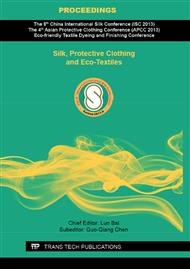[1]
S. Bhadra, D. Khastgir, N. K. Singha, Progress in preparation, processing and applications of polyaniline, Progress in Polymer Science. 34(2009) 783–810.
DOI: 10.1016/j.progpolymsci.2009.04.003
Google Scholar
[2]
N. K. Guimard, N. Gomez, C.E. Schmidt, Conducting polymers in biomedical engineering, Progress in polymer science. 32(2007) 876-921.
DOI: 10.1016/j.progpolymsci.2007.05.012
Google Scholar
[3]
A. Andreatta, Y. Cao, Electrically-conductive fibers of polyaniline spun from solutions in concentrated sulfuric acid, Synthetic Metals. 26(1988) 383-389.
DOI: 10.1016/0379-6779(88)90233-0
Google Scholar
[4]
D. Bowman, B. R. Mattes, Conductive fiber prepared from ultra-high molecular weight polyaniline for smart fabric and interactive textile applications, Synthetic Metals. 154(2005) 29-32.
DOI: 10.1016/j.synthmet.2005.07.017
Google Scholar
[5]
J. M. Jiang, W. Pan, S. L. Yang, Electrically conductive PANI-DBSA/Co-PAN composite fibers prepared by wet spinning , Synthetic Metals. 149(2005) 181-186.
DOI: 10.1016/j.synthmet.2004.12.008
Google Scholar
[6]
M. Khalid,F. Mohammad, FTIR spectroscopic characterization and isothermal stability of differently doped fibrous conducting polymers based on polyaniline and nylon-6, 6, Synthetic Metals. 159(2009)119-122.
DOI: 10.1016/j.synthmet.2008.08.005
Google Scholar
[7]
B. Kim, V. Koncar, E. Devaux, Electrical and morphological properties of PP and PET conductive polymer fibers, Synthetic Metals. 146(2004)167-174.
DOI: 10.1016/j.synthmet.2004.06.023
Google Scholar
[8]
M. K. Shin,Y. J. Kin,S. I. Kim, Enhanced conductivity of aligned PANI/PEO/MWNT nanofibers by electrospinning, Sensors and Actuators B: Chemical. 134(2008) 122-126.
DOI: 10.1016/j.snb.2008.04.021
Google Scholar
[9]
W. J. Liu, G.M. Wu, W.H. Ma, Preparation and properties of the conductive composite fiber from polyaniline and PET fiber with sodium van date as oxidant, Polymer Materials science and Engineering. 13(1997), pp.71-72.
Google Scholar
[10]
A. S. Chandran S.K. Narayanankutty, An elastomeric composite based on polyaniline coated nylon fiber and chloroprene rubber , European Polymer Journal. 44(2008) 2418-2429.
DOI: 10.1016/j.eurpolymj.2008.05.012
Google Scholar
[11]
H. Zhang, L. J. Wang, Study on the preparation and structural performance of polyaniline/PP conductive fiber, Synthetic Fiber in China. 36(2008) 17-20.
Google Scholar
[12]
W. Li, Q. L. Zhuang, X. Ding, Fabrication of electrically conducting PANI/Spandex composite yarns, Journal of Donghua University. 12(2004) 87-90.
Google Scholar
[13]
J. H. Hong, M. Li, Z. J. Pan, Preparation and properties of PTT /PANI composite conductive fibers, Journal of Textile Research. 33(2012) 1-6.
Google Scholar
[14]
J. Stejskal, M. Trchová, J. Kovárová, Polyaniline-coated cellulose fibers decrorated with silver nanoparticles, Chemical Papers. 62(2008) 181-186.
DOI: 10.2478/s11696-008-0009-z
Google Scholar
[15]
Y. Y. Xia, Y. Lu, Fabrication and properties of conductive conjugated polymers/silk fibroin composite fibers, Composites Science and Technology. 68(2008)1471-1479.
DOI: 10.1016/j.compscitech.2007.10.044
Google Scholar
[16]
H. Huang, Z. C. Guo, Preparation and applications of conducting PANI, Science Press, Beijing, (2010).
Google Scholar
[17]
H. Zhang, Y. Li, Z.D. Xu, Preparation and fundamental application research on polyaniline compound conductive fiber, Shanghai Textile Science & Technology. 33(2005) 52-57.
Google Scholar
[18]
H. J. Liu, Y. N. Pei, D. Xie, Surface modification of ultra-high molecular weight polyethylene (UHMWPE) by argon plasma , Applied Surface Science. 256(2010)3941-3945.
DOI: 10.1016/j.apsusc.2010.01.054
Google Scholar
[19]
M. Khalid, F. Mohammad, Preparation, FTIR spectroscopic characterization and isothermal stability of differently doped fibrous conducting polymers based on polyaniline and nylon-6, 6, Synthetic Metals. 159(2009) 119 -122.
DOI: 10.1016/j.synthmet.2008.08.005
Google Scholar


